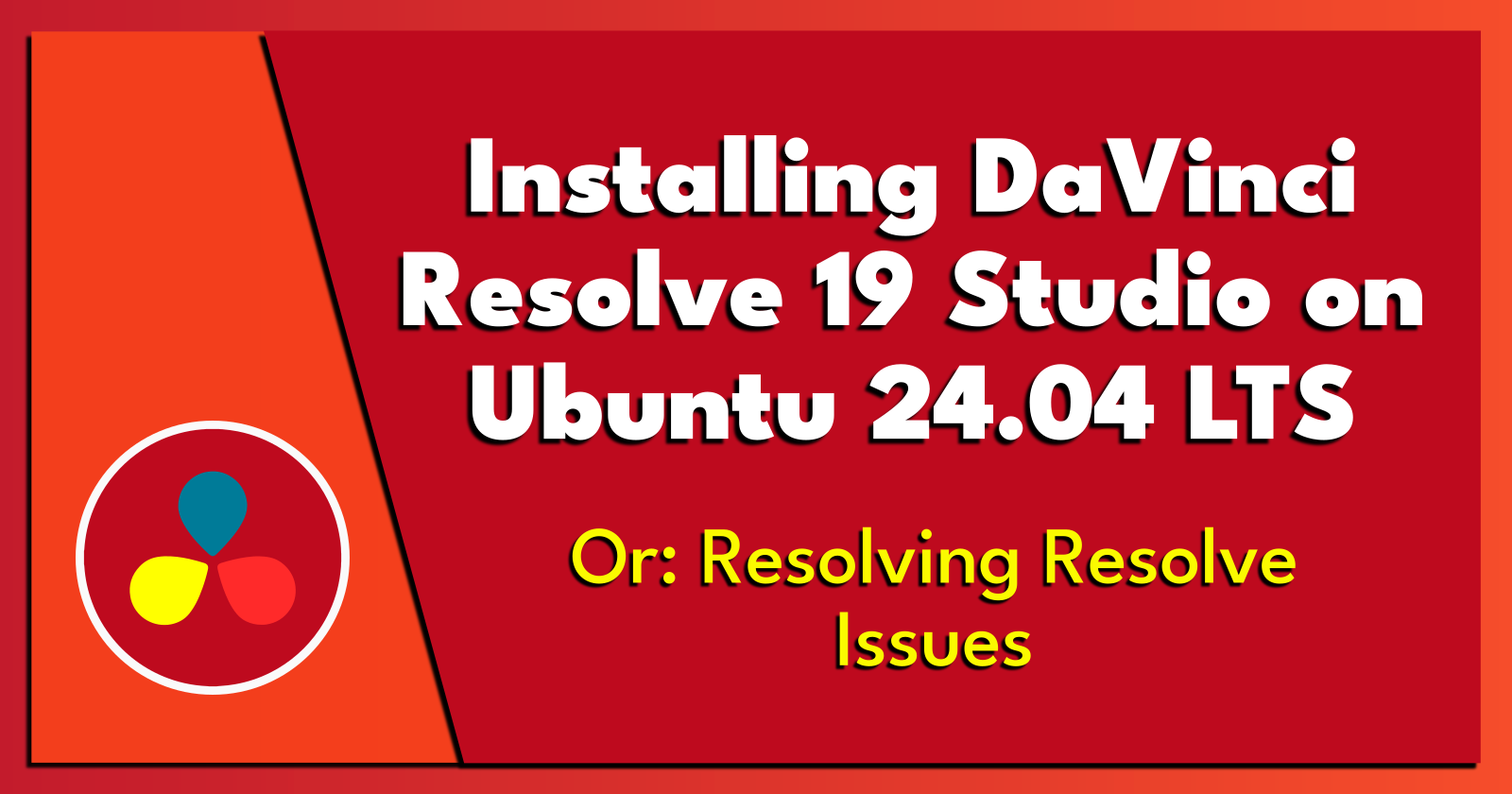Installing DaVinci Resolve 19 Studio on Ubuntu 24.04 LTS.
 Brian King
Brian KingTable of contents

Update: 15th March 2025.
TL;DR.
This post provides a step-by-step guide to installing DaVinci Resolve 19 Studio on Ubuntu 24.04 LTS. It covers downloading the software, preparing the download, ensuring compatibility with necessary libraries, and updating my drivers. By following these instructions, I can effectively set up DaVinci Resolve Studio for professional video editing on my Linux system.
NOTE: This guide has only been tested with the Studio version of Resolve. Let me know, in the comments below, if this process also works with the FREE version of DaVinci Resolve. Thank-you.
Attributions:
hackmd.io ↗,
An Introduction.
Resolve is a great tool for performing many video post production activities.
The purpose of this post is to describe how to install Resolve Studio on Ubuntu.
The Big Picture.
DaVinci Resolve Studio is traditionally thought of as an industry-standard colour correction and colour grading system. But since 2009, Resolve Studio has slowly evolved into a complete, powerful, video production tool with features like:
Video editing,
Special effects,
Motion graphics, and
Audio post-production.
For professional film productions, the Studio version of Resolve actively supports the workflows of many on-set DITs (Digital Imaging Technicians) as well as activities like editing, colour correction, colour grading, visual effects, green screen work, matte paintings, sound effects, audio post-processing and balancing, and audio mixing.
Prerequisites.
- A Debian-based Linux distro (I use Ubuntu).
Updating my Base System.
- From the (base) terminal, I update my (base) system:
sudo apt clean && \
sudo apt update && \
sudo apt dist-upgrade -y && \
sudo apt --fix-broken install && \
sudo apt autoclean && \
sudo apt autoremove -y
NOTE: The Ollama LLM manager is already installed on my (base) system.
What is DaVinci Resolve Studio?
DaVinci Resolve Studio is a paid video editing, colour grading and correction, visual effects, motion graphics, and audio post-production application for macOS, Windows, and Linux. It was originally developed by da Vinci Systems as da Vinci Resolve. Then in 2009, when da Vinci Systems was acquired by Blackmagic Design, the application was rebranded as DaVinci Resolve.
https://www.blackmagicdesign.com/↗.
Installing the Required Packages.
In a terminal, I install the required packages:
sudo apt install -y libqt5x11extras5
Downloading DaVinci Resolve Studio.
- I download the latest copy of DaVinci Resolve 19 Studio:
https://www.blackmagicdesign.com/au/support/family/davinci-resolve-and-fusion
Unzipping the Downloaded File.
- In a terminal, I go to the Downloads directory:
cd ~/Downloads
- I check if the downloaded ZIP file exists:
ls
- I install UNZIP (if required):
sudo apt install unzip
- I extract the contents of the ZIP file:
sudo unzip ./DaVinci_Resolve_*_Linux.zip
Changing the Mode of the RUN File.
- I change the mode of the extracted RUN file to an executable:
sudo chmod +x ./DaVinci_Resolve_Studio_*_Linux.run
Installing the Software.
- I install the software:
sudo SKIP_PACKAGE_CHECK=1 ./DaVinci_Resolve_*_Linux.run -i
NOTE: This command does not check for missing libraries during the installation.
- I change to the
libsdirectory:
cd /opt/resolve/libs
- I make a new directory called
disabled_libs:
sudo mkdir ./disabled_libs
- I move the
libglib,libgio, andlibgmoduleinto thedisabled_libsdirectory:
sudo mv libglib-2.0.so* libgio-2.0.so* libgmodule-2.0.so* disabled_libs/
NOTE: Moving these libraries forces Resolve to use the Ubuntu 24.04 LTS libraries.
- I update my NVIDIA drivers, if required:
sudo apt install -y nvidia-driver-550
NOTE: Resolve Studio requires the 550 drivers (or later) for NVIDIA GTX GPUs.
- I run the application:
/opt/resolve/bin/resolve
The Results.
Installing DaVinci Resolve 19 Studio on Ubuntu 24.04 LTS involves several steps, including downloading the Resolve software and ensuring compatibility with the system drivers and libraries. By following this outlined process, I can successfully set up a powerful video editing tool on my Linux system. With Resolve Studio, I can enhance my video editing capabilities and create professional-level video content.
In Conclusion.
I discovered how to install DaVinci Resolve 19 Studio on Ubuntu 24.04!
DaVinci Resolve is a powerhouse application from Blackmagic Design. It is used for video editing, colour grading, visual effects, and more.
Here's my quick guide to getting started:
I use a Debian-based Linux distro (like Ubuntu).
I update my base system via the terminal.
I download the latest version of DaVinci Resolve 19 Studio from the Blackmagic Design website.
I unzip the downloaded file.
I make the unzipped RUN file executable.
I install the software while repressing error messages.
I move specific libraries to another directory.
I update my NVIDIA drivers to 550 or later.
I run the application and start creating professional-level video content!
By following these steps, I can harness the full potential of DaVinci Resolve Studio on my Linux system.
Are you ready to transform your video editing experience? What projects are you excited to work on with DaVinci Resolve Studio? Let me know in the comments!
Until next time: Be safe, be kind, be awesome.
Hash Tags.
#BlackmagicDesign #DaVinciResolve19 #DaVinciResolve19Studio #VideoEditing #ColourGrading #VideoProduction #VideoPost #VideoPostProduction #VideoContentCreation #FilmEditing #CreativeEditing #ProfessionalVideoEditing #MotionGraphics #AudioPostProduction #LinuxVideoEditing
Subscribe to my newsletter
Read articles from Brian King directly inside your inbox. Subscribe to the newsletter, and don't miss out.
Written by

Brian King
Brian King
Thank you for reading this post. My name is Brian and I'm a developer from New Zealand. I've been interested in computers since the early 1990s. My first language was QBASIC. (Things have changed since the days of MS-DOS.) I am the managing director of a one-man startup called Digital Core (NZ) Limited. I have accepted the "12 Startups in 12 Months" challenge so that DigitalCore will have income-generating products by April 2024. This blog will follow the "12 Startups" project during its design, development, and deployment, cover the Agile principles and the DevOps philosophy that is used by the "12 Startups" project, and delve into the world of AI, machine learning, deep learning, prompt engineering, and large language models. I hope you enjoyed this post and, if you did, I encourage you to explore some others I've written. And remember: The best technologies bring people together.